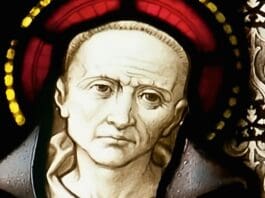
Saint Petroc was the younger son of the King Glywys. On his father’s death, the people of Glywysing called for Petroc to take the crown of one the country’s sub-divisions, but Petroc wanted a religious life, and went to study in Ireland.
Several years later he returned to Britain, landing on the River Camel in Cornwall. Directed by Saint Samson to the hermitage of Saint Wethnoc. Wethnoc agreed to give his cell to Petroc in order that he could found a monastery on the site.
After 30 years as abbot, Petroc made a pilgrimage to Rome, Italy. On his return, just as he reached Newton Saint Petroc, it began to rain. Petroc predicted it would soon stop, but it rained for three days. In penance for presuming to predict God’s weather, Petroc returned to Rome, then to Jerusalem, then to India where he lived seven years on an island in the Indian Ocean.
Petroc returned to Britain with a wolf companion he had met in India. Founded churches at Saint Petrox and Llanbedrog. In Cornwall, with the help of Saint Wethnoc and Saint Samson, he defeated a mighty serpent that King Teudar of Penwith had used to devour his enemies. He then left his monastery at Llanwethinoc to live as a hermit in the woods at Nanceventon, some fellow monks following his example at Vallis Fontis.
While in the wilderness, a hunted deer sought shelter in Saint Petroc’s cell. Petroc protected it from the hunter, King Constantine of Dumnonia, and converted the king to Christianity in the bargain.
St. Petroc later moved deep into the Cornish countryside, encountering the hermit Saint Guron. Guron moved south allowing Petroc, with the backing of King Constantine, to establish a monastery called Bothmena (the Abode of Monks) at the site of the hermitage.
Photo credit: Public Domain via Wikimedia Commons
The post Saint Petroc appeared first on uCatholic.
Daily Reading
Saturday of the Sixteenth Week in Ordinary Time
Reading 1 Jer 7:1-11 The following message came to Jeremiah from the LORD:Stand at the gate of the house of the LORD,and there proclaim this message:Hear the word of the…
Daily Meditation
Planted in You
Click here for daily readings I’ve recently had some remodeling done in my home. My dwelling place is a sound structure. Built in the mid 70’s, wear and tear in…




